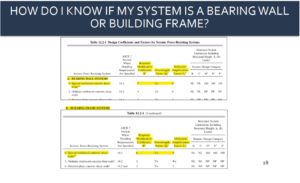If a building consists of bearing walls, shear walls, and braced frames, should the building be classified as a bearing wall system or a building frame system? While an argument can be made in favor of each side, which system is the most appropriate?
In the June 2023 SEU session, Emily Guglielmo, PE, SE, from Martin/Martin, presented ASCE 7 Frequently Asked Questions (Seismic). Emily covered many frequently asked questions regarding seismic design according to ASCE7 and explained the rationale for key updates to ASCE 7-16 and ASCE 7-22 seismic load provisions.
 Emily addressed a common question encountered by engineers when determining what type of seismic force resisting system is most applicable to their structure. While a moment frame system is quite obvious, distinguishing the difference between a bearing wall or building frame system can be more challenging.
Emily addressed a common question encountered by engineers when determining what type of seismic force resisting system is most applicable to their structure. While a moment frame system is quite obvious, distinguishing the difference between a bearing wall or building frame system can be more challenging.
A bearing wall system is defined as a structural system with bearing walls providing support for all or major portions of the vertical loads. Shear walls or braced frames provide seismic force resistance. A building frame system is a structural system with an essentially complete space frame providing support for vertical loads and the seismic forces are resisted by shear walls or braced frames. As Emily pointed out, these definitions leave some ambiguity as to how the vertical loads are supported.
How then should an engineer decide between the two for a structure which is comprised of bearing walls, shear walls, and braced frames? Selecting a system with a higher R value would reduce the seismic base shear, but Emily explained that the intent of the provisions is to prevent a situation where a brittle and catastrophic failure of a lateral force-resisting element also results in the collapse of the vertical load carrying capacity of the building. Thus, when deciding whether a “major” portion of the vertical load is supported by columns or bearing walls, the engineer may want to consider the intent of the provision rather than adhere to a stringent 51/49 percent determination on how the vertical loads are supported. Emily advised using a lower R value in cases where shear walls provide a good portion of the gravity loads since this type of system can result in more catastrophic damage in a seismic event if the lateral system is damaged or fails.
